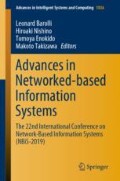Abstract
At the present time, since mobile devices such as tablet-type PCs and smart phones have widely penetrated into our daily lives, an authentication method that prevents shoulder surfing attacks comes to be important. We are investigating a new user authentication method for mobile devices that uses surface electromyogram (s-EMG) signals, not screen touching. The s-EMG signals, which are generated by the electrical activity of muscle fibers during contraction, can be detected over the skin surface, and muscle movement can be differentiated by analyzing the s-EMG signals. Taking advantage of the characteristics, we proposed a method that uses a list of gestures as a password in the previous study. In order to realize this method, we have to prepare a sufficient number of gestures that are used to compose passwords. In this paper, we adopted fingerspelling as candidates of such gestures. We measured s-EMG signals of manual kana of The Japanese Sign Language syllabary and evaluated their potential as the important element of the user authentication method.
Access this chapter
Tax calculation will be finalised at checkout
Purchases are for personal use only
References
Tamura, H., Okumura, D., Tanno, K.: A study on motion recognition without FFT from surface-EMG. IEICE Part D J90-D(9), 2652–2655 (2007). (in Japanese)
Yamaba, H., Nagatomo, S., Aburada, K., et al.: An authentication method for mobile devices that is independent of tap-operation on a touchscreen. J. Robot. Netw. Artif. Life 1, 60–63 (2015)
Yamaba, H., Kurogi, T., Kubota, S., et al.: An attempt to use a gesture control armband for a user authentication system using surface electromyograms. In: Proceedings of 19th International Symposium on Artificial Life and Robotics, pp. 342–345 (2016)
Yamaba, H., Kurogi, T., Kubota, S., et al.: Evaluation of feature values of surface electromyograms for user authentication on mobile devices. Artif. Life Robot. 22, 108–112 (2017)
Yamaba, H., Kurogi, T., Aburada, A., et al.: On applying support vector machines to a user authentication method using surface electromyogram signals. Artif. Life Robot. (2017). https://doi.org/10.1007/s10015-017-0404-z
Kurogi, T., Yamaba, H., Aburada, A., et al.: A study on a user identification method using dynamic time warping to realize an authentication system by s-EMG. In: Advances in Internet, Data & Web Technologies (2018). https://doi.org/10.1007/978-3-319-75928-9_82
Yamaba, H., Aburada, A., Katayama, T., et al.: Evaluation of user identification methods for an authentication system using s-EMG. In: Advances in Network-Based Information Systems (2018). https://doi.org/10.1007/978-3-319-98530-5_64
Yamaba, H., Inotani, S., Usuzaki, S., et al.: Introduction of fingerspelling for realizing a user authentication method using s-EMG. In: Advances in Intelligent Systems and Computing (2019). https://doi.org/10.1007/978-3-030-15035-8_67
Kita, Y., Okazaki, N., Nishimura, H., et al.: Implementation and evaluation of shoulder-surfing attack resistant users. IEICE Part D J97-D(12), 1770–1784 (2014). (in Japanese)
Kita, Y., Kamizato, K., Park, M., et al.: a study of rhythm authentication and its accuracy using the self-organizing maps. In: Proceeings of DICOMO 2014, pp. 1011–1018 (2014). (in Japanese)
Acknowledgements
This work was supported by JSPS KAKENHI Grant Numbers JP17H01736, JP17K00139, JP17K00186, JP18K11268.
Author information
Authors and Affiliations
Corresponding author
Editor information
Editors and Affiliations
Rights and permissions
Copyright information
© 2020 Springer Nature Switzerland AG
About this paper
Cite this paper
Yamaba, H. et al. (2020). Evaluation of Manual Alphabets Based Gestures for a User Authentication Method Using s-EMG. In: Barolli, L., Nishino, H., Enokido, T., Takizawa, M. (eds) Advances in Networked-based Information Systems. NBiS - 2019 2019. Advances in Intelligent Systems and Computing, vol 1036. Springer, Cham. https://doi.org/10.1007/978-3-030-29029-0_56
Download citation
DOI: https://doi.org/10.1007/978-3-030-29029-0_56
Published:
Publisher Name: Springer, Cham
Print ISBN: 978-3-030-29028-3
Online ISBN: 978-3-030-29029-0
eBook Packages: Intelligent Technologies and RoboticsIntelligent Technologies and Robotics (R0)

